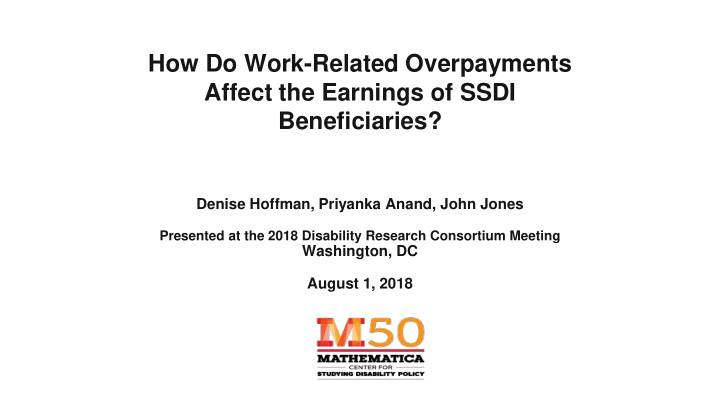



How Do Work-Related Overpayments Affect the Earnings of SSDI Beneficiaries? Denise Hoffman, Priyanka Anand, John Jones Presented at the 2018 Disability Research Consortium Meeting Washington, DC August 1, 2018
An Exaggerated Summary of Our Research Motivation and Question ● SSA: We want beneficiaries of Social Security Disability Insurance (SSDI) to work! ● SSA to a beneficiary: We see you worked! But… because you worked, you shouldn’t have been paid several SSDI checks. You owe us $9,000. ● Beneficiary: ______________ 2
Employment Among SSDI Beneficiaries Is Desirable but Rare ● Employment may have benefits for SSDI beneficiaries and the SSDI trust fund ● Some beneficiaries work, but few engage in substantial gainful activity (SGA) Source: Liu and Stapleton 2011. 3
A More Formal Definition of “Overpayment” ● SSDI eligibility requires an inability to engage in SGA ($1,070/month in 2014, nonblind) ● After a beneficiary engages in SGA for 12 months at most, SSA suspends or terminates benefits ● If SSA does not adjust benefits in a timely way, the beneficiary is overpaid – Often caused by delays in beneficiary reporting or SSA delays in processing information – The beneficiary must repay the debt 4
Overpayments Are Prevalent Among SSDI Beneficiaries Who Engage in SGA Source: Hoffman et al. 2018. 5
There Is No Consensus on How Overpayments Affect Beneficiaries’ Earnings Some may maintain or increase earnings Some may reduce earnings Sources: Derr et al. 2015; O’Day et al. 2016; Hoffman et al. 2018; Kregel et al. 2018. 6
There Is No Consensus on How Overpayments Affect Beneficiaries’ Earnings 75% reduce earnings Sources: Derr et al. 2015; O’Day et al. 2016; Hoffman et al. 2018; Kregel et al. 2018. 6
Overview of Empirical Analysis What is the impact of a work-related overpayment on beneficiary earnings? ● Analysis of within-person changes before and after overpayment notification ● 13-month analysis window: 6 months before and after overpayment notification 7
Data Sources ● Recovery of Overpayments, Accounting, and Reporting (ROAR) – Work-related overpayment identified between 2007 and 2014 ● 2016 Disability Analysis File (DAF) – Beneficiary- and program-related characteristics, SGA engagement 8
Sample Restrictions ● The timing of the overpayment notification is unexpected by the beneficiary – SSA discovered unreported earnings – It is the first overpayment for the beneficiary ● Overpayment is for a primary beneficiary living in the U.S. ● No missing data on SGA status in 13-month analysis window 9
Outcome: Engagement in SGA ● Constructed measure based on two DAF variables – Indicator for countable earnings at or above SGA – Indicator for benefit suspense because of SGA-level employment 10
Beneficiaries May Reduce Earnings in Response to Other SSA Mailings ● About one year before the overpayment notice: Request for detailed information on earnings ● About four to six weeks before the overpayment notice: Final opportunity for the beneficiary to submit information that may affect SGA determination ● About two weeks before the overpayment notice: SSA determined that benefits ceased because of engagement in SGA Sources: SSA 2016; conversation with former SSA field office employee. 11
The Proportion Engaging in SGA Is Associated with Overpayment Notification 60% -0.8 ppt Proportion of beneficiaries engaging -1.1 ppt -1.5 ppt -1.4 ppt -1.8 ppt 50% 40% in SGA 30% 20% 10% 0% -6 -5 -4 -3 -2 -1 0 1 2 3 4 5 6 Months relative to overpayment notification month 12
The Proportion Engaging in SGA Is Associated with Overpayment Notification 60% -0.8 ppt Proportion of beneficiaries engaging -1.1 ppt -1.5 ppt -1.4 ppt -1.8 ppt 50% -2.7 ppt -1.9ppt 40% in SGA 30% 20% 10% 0% -6 -5 -4 -3 -2 -1 0 1 2 3 4 5 6 Months relative to overpayment notification month 12
The Proportion Engaging in SGA Is Associated with Overpayment Notification 60% -0.8 ppt Proportion of beneficiaries engaging -1.1 ppt -1.5 ppt -1.4 ppt -1.8 ppt 50% -2.7 ppt -1.9ppt -0.9 ppt -0.5 ppt -0.5 ppt -0.5 ppt -0.4 ppt 40% in SGA 30% 20% 10% 0% -6 -5 -4 -3 -2 -1 0 1 2 3 4 5 6 Months relative to overpayment notification month 12
Related Next Steps ● Estimate a regression equation where the coefficients of interest are indicators for the six postnotification months – Control for pre-period trends – Explore a new data source to see if we can control for previous SSA notifications ● Understand who we dropped because of missing SGA data ● Test changes to the duration of the analysis window 13
Additional Analysis ● Compare results for beneficiaries who reported their earnings ● Estimate the extent to which beneficiary response varies by the overpayment amount 14
Policy Importance ● If overpayments negatively affect beneficiary earnings, this will add to SSA’s impetus to develop policies that curtail overpayments ● Regardless, preventing overpayments is important for program integrity and beneficiary well-being 15
Contact Information Denise Hoffman Center for Studying Disability Policy Mathematica Policy Research 1100 1 st Street, NE, 12 th Floor Washington, DC 20002 (202) 554-7517 dhoffman@mathematica-mpr.com http://www.DisabilityPolicyResearch.org 16
Recommend
More recommend